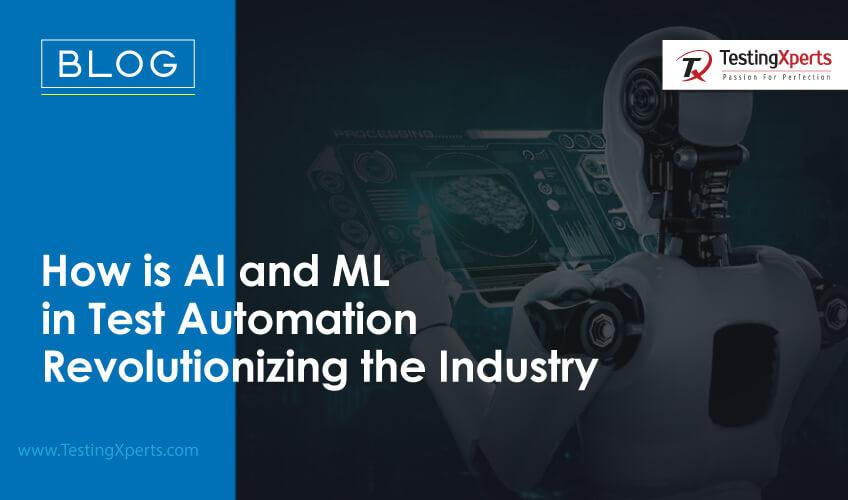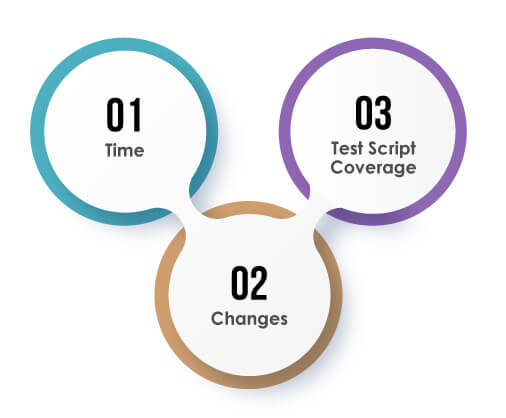Recommended Blogs
How is AI and ML in Test Automation Revolutionizing the Industry

AI and ML in automation have driven a 40% average increase in operational efficiency across industries. From fitness trackers fine-tuning workouts to smart home assistants simplifying routines, they are everywhere. Streaming platforms nail your next movie pick because of them. And in QA, AI-powered testing tools are quietly transforming how tests get done behind the scenes.
Machine Learning creates algorithms that learn from tons of examples. These examples come from curated datasets or other software. No strict rule-based programming needed, and that’s what makes it so adaptable.
Find out how the capabilities of AI and ML in test automation are altering the industry. Explore the best methods to use these tools, technology, and real-world applications.
AI and ML in Automation – Transforming the Industry
The testing process has come a long way, going from classical functional testing to Automation Testing, where Selenium became a popular automation tool. The discipline of software testing, on the other hand, needs to adopt new testing methods in today’s modern world. In response, the emergence of AI-based testing tools has had a huge and long-lasting effect.
Furthermore, organizations are actively seeking tools that can harness the capabilities of AI and ML algorithms to enhance the efficiency of Test Automation. There is a growing recognition that businesses derive substantial advantages from AI-powered automation testing. This approach facilitates expedited and continuous testing, near-complete automation, and accelerated return on investment (ROI).
AI and ML can be easily added to automated software testing processes, which would make test scripts more reliable, competent, and efficient. However, businesses face many problems when using traditional methods of automation testing. AI-powered automation tools can help solve these problems.
How is AI helping Reshape the Automation Industry?

Time:
Each time a new test automation project is initiated, testing teams find themselves rewriting a significant amount of code, regardless of the reusability of components. This repetitive process can be time-consuming, whether it involves implementing a new tool or adapting the existing company framework. AI tools offer a solution by enabling the rapid and automated generation of test scripts.
Changes:
Product teams often make modifications to applications, even if these changes are subtle or imperceptible to users. Such alterations can lead to the failure of test scripts when performing certain actions on the page. AI/ML tools can effectively employ auto-healing techniques to navigate these adjustments and ensure the uninterrupted and error-free execution of test scripts.
Test Script Coverage:
In Agile projects, running the complete regression suite of test cases after every modification may not be a viable option. Nonetheless, AI/ML tools can assist testers in constructing and configuring regression test suites specifically tailored to the particular alterations, taking into account various project parameters and discrepancies.
Save Time with ML-Powered Test Prioritization
Running every test case after every change is overkill and drains time and computing resources. Here’s where Machine Learning steps in.
Test case prioritization using ML means your test suite stops running in a fixed order. Instead, the system analyzes past runs, recent code commits, risk factors, and usage patterns to rank which test cases should run first.
It makes sure critical paths get checked immediately, while low-risk scenarios run later or skip altogether if they haven’t changed.
Example: In a banking app, payment flow and login might always sit at the top, while an admin settings test waits its turn. ML keeps reshuffling priorities as the app evolves, so your pipeline stays lean, fast, and focused on catching real issues.
How AI-Powered Defect Prediction Spots Bugs Before They Happen?
Finding bugs after they hit production wastes time, budget, and customer trust. AI-powered defect prediction flips this by pointing out problem areas before they break your build.
Here is how it works:
Analyzes history: ML scans past bugs, test results, commit history, and code changes to find patterns humans miss.
Flag risky areas: The system shows which modules, files, or lines of code are most likely to fail next.
Targets your tests: Teams can write extra test cases, expand coverage, or run more regression tests on those weak spots.
Reduces surprises: Fewer unexpected bugs mean smoother releases and happier stakeholders.
By following this process, AI and ML spot risk early and turn the test strategy into a proactive approach. It helps your team spend less time scrambling and builds more confidence.
What are the 7 Ways to Use AI and ML in Test Automation?

AI and ML have made a major difference in test automation. Businesses can now see, plan, and do testing in a whole new way with the help of these technologies. Some interesting approaches to use AI and ML in test automation:
Predictive Analysis:
AI and ML in test automation look at historical test data and use algorithms to guess where software might have problems in the future. This capacity to forecast lets test engineers fix problems before they happen, which makes the product better.
Intelligent Test Generation:
AI-powered automated testing tools generate and prioritize test cases based on user activity. This approach ensures critical paths and functions undergo thorough testing, reducing manual effort and ensuring robust software applications.
Visual Validation Testing:
AI and ML in test automation enable comprehensive comparisons of images/screens across different browsers and devices. The system detects minor UI discrepancies, ensuring a consistent user experience across platforms.
Optimized Test Maintenance:
As software evolves, test cases often require updates. AI identifies changes in the application and suggests necessary modifications to the test scripts, streamlining maintenance.
Enhanced Test Coverage:
AI and ML algorithms analyze vast amounts of data from test runs to identify testing gaps. This data-driven approach ensures comprehensive test coverage and reduces potential risks.
Adaptive Continuous Testing:
In Continuous Integration and Continuous Deployment (CI/CD), AI and ML automated algorithms adapt and prioritize tests according to code changes, ensuring recent code alterations receive instant validation.
Natural Language Processing in Test:
AI-powered testing tools with NLP capabilities understand test requirements in plain English, making it feasible for non-technical stakeholders to draft test scenarios.
AI-Powered Test Automation Tools

When employing rudimentary automated testing, individuals like developers, testers, or SDET might rely on code that produces random inputs for various fields. Nevertheless, a significant portion of these tests often become redundant or fail to align with the application’s intended business use. In such scenarios, manually crafted tests prove more valuable since developers possess a deeper understanding of the accurate business flow and usage requirements.
Incorporating AI presents a remarkable prospect for elevating automated testing to align seamlessly with business logic. For instance, users typically add an item to their online shopping cart before being directed to a page where they input their address. Traditional testing often involves checking an API with a static address, but with AI/ML automated testing, it becomes possible to generate a dynamic array of input values that not only adhere to logic but also encompass a more comprehensive evaluation of the applications, leading to more assured and robust outcomes.
This testing approach represents an advanced software testing method that seamlessly incorporates AI, ML, and DL technologies into the realm of automation testing. Its objective is to enhance software quality and accelerate the software delivery process. If you’re eager to harness the potential of AI and ML for robust automation, I wholeheartedly recommend giving ACCELQ a try.
Functional Virtualization and Reconciliation:
Assisting in-sprint automation to synchronize with CI/CD and advancing the practice of shifting left in test automation.
Element handling and bot healing:
Picture your test automation with durability and minimal upkeep. With Bot healing at your disposal, dynamic elements can be consistently identified, putting an end to unreliable or inconsistent tests.
Auto-generation of Test Cases:
Visualize achieving optimal test coverage through the scientific identification of permutations and flows in real-time. This becomes achievable with the automatic generation of test cases, ensuring the most comprehensive test coverage.
Test Data Generator using synthetic data generation:
Synthetic data finds applications across diverse use cases, serving purposes in both functional and non-functional testing. Additionally, it can be harnessed for implementing the data-driven approach effectively.
AI Testing Tools for Test Automation
AI-powered test automation tools use technologies like Artificial Intelligence and Machine Learning to enhance and streamline the software testing process. There are various examples of test automation tools, including:
Testim:
Testim uses AI-driven self-healing to keep UI tests stable and automatically fixes flaky scripts as your app evolves.
Mabl:
Mabl is an intelligent test automation platform that combines low-code authoring with ML-powered test maintenance and visual change detection.
Applitools:
It leverages Visual AI to spot even the smallest UI bugs across browsers and devices, ensuring a consistent user experience.
Tricentis Tosca:
A model-based test automation suite that uses AI to optimize end-to-end test design, execution, and maintenance for complex enterprise systems.
Functionize:
Functionize blends NLP and ML to turn plain-English test cases into robust, self-healing automated tests that adapt to app changes.
Testsigma:
It is a unified AI-powered test automation tool that lets teams write tests in simple English while auto-maintaining scripts as the app evolves.
Parasoft Selenic:
Parasoft Selenic enhances Selenium tests with AI-powered self-healing and smart recommendations to reduce flaky test failures.
Katalon Studio:
This tool combines low-code test creation with built-in AI capabilities to accelerate web, API, mobile, and desktop test automation.
Conclusion
As leaders in the realm of digital assurance, it is essential for us to continually acquire knowledge and adjust to the evolving landscape of technologies and business methodologies in today’s dynamic world. Moreover, it’s imperative that we familiarize ourselves with cutting-edge AI-based tools and acquire the requisite skills to enhance our productivity and achieve success.
How Can TestingXperts help you with AI and ML Automation?
With our proven AI testing processes and in-house automation accelerators, we significantly reduce testing timelines, aiding you in achieving faster time-to-market for your AI-driven applications.
• TestingXperts has developed proprietary automation accelerators, such as AI-driven test data generators and pre-built automation frameworks, ensuring robust and resilient AI test automation.
• We focus on rigorous testing to uncover potential risks early in the development lifecycle, thus enabling proactive risk mitigation strategies and ensuring a robust AI solution.
• Over 40% reduction in regression testing time achieved through AI-based test automation services.
• 95%+ accuracy in AI algorithm validation using our specialized AI testing methodologies.
• 30% faster time-to-market for AI-powered applications with our agile AI testing frameworks.
FAQs
AI makes test automation better by letting scripts fix themselves, creating smart test cases, finding anomalies, and doing predictive analytics. It makes tests more efficient and cuts down on the work needed to keep things running.
AI/ML reduces test maintenance, detects flaky tests, improves test accuracy, enables faster issue detection, and offers predictive analytics. These benefits lead to smarter automation, quicker releases, and enhanced decision-making throughout the software development lifecycle.
AI/ML is ideal for complex, large-scale, and frequently changing projects. It may not offer significant ROI for small or static applications where traditional test automation already performs efficiently with minimal maintenance needs.
Discover more
Stay Updated
Subscribe for more info


